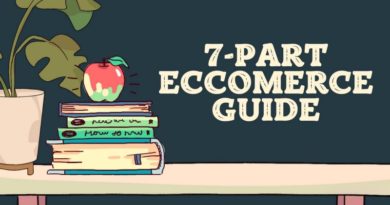How To Choose A Great Niche And Great Products For Your Ecommerce Store
This is the toughest part of building a successful ecommerce store

If you want to build a successful ecommerce store, you need to choose a great niche as well as great products. This is what most people find to be the toughest part of the whole process. Get this wrong and nothing else will matter.
Choosing a niche and products is STEP 1 of my guide to making money from ecommerce and dropshipping. If you haven’t done so already, I strongly suggest you read that first. It’s good to have a basic overview before diving into the details.
How To Make Money From Ecommerce & Dropshipping
As already mentioned above, this is the step that you really need to get right. It’s the part that most people fail at. But don’t worry about failure right now because the next step will be testing whether your products can sell or not. If they don’t sell you skip back to this step and try again.
I know people that tested many niches and products before they finally hit upon success.
This part takes a lot of hard work. It’s not a case of sitting down for 2 minutes and going ahead with whatever idea comes into your head. The initial ideas tend to be the worst. Ask most people for product ideas and they’ll mention t-shirts, phone cases, and similar common items.
As well as being common items, they’re also items that have very low profit margins. You need products with high profit margins. You need to make enough profit to pay for the product, shipping, ads, and a host of other costs.
Choosing a suitable niche
I would suggest putting aside 2–3 hours to work on this. This will be the start. You may have to put in 2–3 hours every day for a few days or even a few weeks before you come up with some viable niches. Some people can figure this out in a day, while others don’t seem able to think of any niches at all.
To start, head over to this site that has a list of 2,531 niche ideas. The site is about affiliate marketing but that doesn’t matter. We’re only interested in finding some good niches to get started. It is worth reading the entire article, as it contains some great general info on niches.
You may now be overwhelmed with what niche to choose. Don’t be.
What you need to find is a niche that you have at least some interest in. Running an ecommerce store can be fun if you’re selling products you love. It can be soul-destroying if you’re selling products you hate. So make life easy and choose a niche that you love or at least like.
Another thing to consider is that potential customers will ask you questions about the products you’re selling. If you detest golf, you likely won’t be able to answer a question about which particular golf club will suit the customer best. That will result in lost sales.
If you’re an amateur golfer you may be able to answer the question easily. The customer will realize that you know what you’re talking about. This will result in more sales.
Some of you will be wondering why you need to communicate with customers if you’re running an online store. Believe it or not, some customers still need help with their purchases. They want to make sure they’re buying the right product, especially if it’s expensive.
I can’t tell you what niche to choose, as it’s a very personal decision. We all enjoy different things, so are suited to different niches.
Go through the list on the website mentioned and make your own list of possible niches. Don’t just choose one. Choose however many you think could work for you.
Choosing Products
The next step is to see if your chosen niche(s) has some suitable products you can sell.
If you chose the golfing niche, make a list of golfing products that you might be able to sell. This should be a niche you have some understanding of, so you should know what products fit in that niche. If you need to brainstorm extra products, search online for stores selling similar products to see what they sell.
Once you’ve completed this step you should have a list of a few niches and some suitable products. Next, we need to find out if these products have enough profit margin to make them viable.
Pricing
This is also a very tough part to figure out. I would avoid selling low-cost products. They can work but they’re more for experienced sellers.
If you buy a product for $10 and sell it for $20 it sounds like you made a $10 profit. In reality, most people will lose money. The cost of ads, warehouse storage, picking and packing, shipping, and returns will eat away at that profit.
When I had my ecommerce store, most of my products were in the $200-$400 range. I might buy a product for $100 and sell it for $200 while making a $40–50 profit. The profit could sometimes be lower.
It did sell lower-priced products, but there wasn’t enough profit margin to be able to afford ads. I relied on customers adding them to the cart along with a more expensive product.
It’s also easier if you sell fewer products with bigger profits. If each product makes a $5 profit you’d need to sell 200 to make $1,000. If the profit is $50 you only need to sell 20. Dealing with 20 customers is fairly easy. Dealing with 200 will be overwhelming if they’re emailing asking questions about the products, shipping times, and other things.
How to work out the profit margin can be tricky. As a ballpark figure, I assume that the profit will be around 40% of the selling price, before costs.
If you see a product being sold for $200, you can assume that it will cost 60% of that, so $120. That leaves you with an $80 profit. From that, you need to subtract the cost of ads, shipping, etc.
These figures can vary widely, but at this stage, we just want to rule out products that won’t work for us. We will dig deeper later.
So, in the example above, we have a possible $80 profit. I’d guess around $20–$30 in ad costs per sale, so that still leaves $50–$60 profit. Shipping and warehouse costs should only be $5–$10, so a product like that sounds viable.
Go through each product and rule in or rule out each one based on the calculations above. There’s no perfect way to do this. You have to use a lot of common sense.
Suppliers
Next, you need to find suppliers. It’s at this stage that you’ll find out the real pricing. This is another tough part and can take weeks to complete.
While I’m sure that there are at least a few people successfully importing from places like Alibaba and AliExpress in China, I don’t recommend this. They mostly sell generic products. Everyone can easily find these products, so competition will be brutal.
What you need to do is find local suppliers. This means putting in some serious research to find them. Don’t rely on lists of dropshippers. It’s not what you need.
If you know your niche you should already know some suppliers. If not, you can use Google as a starting point. Looking at product packaging can also lead you to suppliers.
Once you have a list of possible suppliers, you need to contact them. I’d suggest calling them and introducing yourself. Tell them what your plans are and ask if they can supply you with products.
In the beginning, it’s a good idea to get products dropshipped, as it means you won’t have to buy in bulk. This will allow you to test the market.
What I found was that many suppliers only want to deal with real businesses. I was told by a few to get back to them when I was up and running. This ends up being a catch-22 situation. You can’t start without suppliers, but suppliers don’t want to sell to you until you’ve started.
There is no easy way around this. You just have to keep searching for suppliers. If one or two agree to supply you, you can get started. Once started, it will be easier to get the others on board.
A year or two ago I saw a dropshipping business listed for sale. They sold auto parts that were all dropshipped. They negotiated with 5 or 6 local suppliers in Australia to supply them. They made a profit of over $40,000 a month. That’s the ideal type of deal. It’s your job to hunt down these suppliers. It’s not easy. But the effort is worth it.
Conclusion
That’s it. Simple, right? Well, the concept is simple, but it takes a lot of hard work to find the right products.
Remember — think outside the box. Don’t try to sell clothing, jewelry, cosmetics, candles, and other such products. Every man and his dog is selling these. Aim for products with less competition. Like auto parts, as mentioned in the example above.


